Determination of PV Module Potential Using Estimates of Hourly Irradiance and Temperature for Bambili
Abstract
The amount of irradiance incident on a photovoltaic module and the module temperature are essential parameters to estimate its performance and forecast its energy output. These data are often available only where there are meteorological stations. Consequently, other methods are required to estimate these data. The objective of this work was to estimate the irradiance and temperature from different models and further estimate the annual energy output for Bambili, Cameroon. To this effect, mathematical models such as Angstrom–Prescott (A-P), Kaplanis, Duffie and Beckman, and Collares-Pereira and Rabl were employed for the estimation of irradiance, while the WAVE, SOYGRO, and Parton and Logan models were used for temperature computations. Collares-Pereira and Rabl irradiance models showed a lower percentage root mean square error (RMSE) value of 6.71 with respect to the National Aeronautics and Space Administration (NASA), while for temperature models, Parton and Logan performed better from 6 a.m. to noon and SOYGRO from 1 to 6 p.m. with percentage RMSE values of 7.17 and 9.86, respectively. With the estimated irradiance and temperatures from the models, the monthly and annual energy outputs were computed using mathematical models of the PV module. The percentage RMSE of the annual energy estimated with respect to the Photovoltaic Geographical Information System (PVGIS) was found to be 1.95 and 4.40 for BP3125 and BP3180 modules, respectively, while the percentage RMSE of the annual energy estimated with respect to Photovoltaic Software (PVsyst) was found to be 2.14 and 4.22 for BP3125 and BP3180 modules, respectively. In conclusion, the results showed that Collares-Pereira and Rabl, SOYGRO, and PV model equations can be employed with BP3125 and BP3180 PV modules for the estimation of energy output for Bambili and other locations with no meteorological stations or internet services.
1. Introduction
Irradiance (G) and temperature (T) data availability have been major challenges in Bambili, Cameroon. This scarcity of data has decreased the rate of implementation of PV systems and increased the use of nonrenewable sources of energy. Photovoltaic systems still confront several obstacles because of atmospheric variations and the unpredictability of PV systems [1]. The most crucial parameters to consider when evaluating the output and efficiency of a PV system are irradiance, expressed as the power density of solar radiation that reaches the photovoltaic device, and cell temperature [2]. It is advantageous to take temperature and irradiance into account as PV performance metrics because of the strong relationship that exists between PV power and atmospheric factors. Therefore, in order to optimize the entire operation and boost the economic feasibility of PV systems, there is a need to create trustworthy mathematical models to determine their performance parameters (irradiance and temperature) [3].
In practical terms, pyranometers are tools often employed for measuring irradiance [4]. Pyranometers’ main drawbacks are their expensive nature, consisting of many sensors, and the requirement for the equipment to face towards the PV modules [5]. The use of pyranometers to assess irradiance is still uncommon in large areas like Bambili, Cameroon. On the other hand, meteorological stations for recording these data are also not available in Bambili. To an extent, the irradiance data for Bambili, Cameroon, are mostly obtained from other meteorological websites, such as NASA. However, these NASA data are mostly nonreal ground data since they are atmospheric data obtained from faraway satellites [6]. Such data might be of less use in sizing real-time PV systems. To increase PV system performance, precise methods for estimating solar irradiance must be developed [7]. Therefore, there is a need to use mathematical models to estimate the irradiance and temperatures of a particular location, which will approximate the real ground data.
Estimating irradiance and temperature is fundamental to several fields, including climatology, quality control, building automation, meteorology, and most importantly, PV applications. Temperature and irradiance readings are very important for researchers, independent test facilities, or factory producers to verify the advertised specifications of the equipment [3, 5]. In order to predict the alternating current (AC) output of PV systems and connect the electrical characteristics of the system to its operating points, it is necessary to have knowledge of the module temperature and solar radiation levels [8]. Furthermore, power-generating plants can increase the incorporation of PV energy output into the grid via the electrical network by optimizing energy management based on the knowledge of future yields from PV installations. This yield depends mostly on the amount of irradiance and temperature levels of the PV module [9].
2. Literature Review
This discussion included various mathematical and day-of-the-year-based models to determine irradiance on level and tilt surfaces, temperature at various sites, as well as energy output. A technique for calculating irradiance on flat and tilted south-oriented surfaces was presented in [10]. Utilizing certain meteorological data from Port Harcourt, Nigeria, the Duffie and Beckman model was used to estimate irradiance on tilted and horizontal surfaces. The deduced irradiance statistics for the city demonstrate that the potential of irradiance is higher during the dry season than in the wet season. An irradiance model based on an artificial neural network was formulated in [11]. They employed the daily mean of irradiance to forecast hourly data, with 43,800 hourly irradiance data points used in the training and validation of the model in Matrix Laboratory (MATLAB). This model showed better performance compared to other models based on statistical methods. In the conference proceedings held in the city of Framantum, North Cyprus, emphasis was laid on irradiances as the primary parameter that gives knowledge about the region’s PV energy potential [12]. As a result, this parameter is critical for effective PV system optimization. However, a straightforward estimating method for irradiance on tilt and level surfaces was created in order to enable the assessment of the quantity of thermal energy at every instant getting inside a complex environment supplied with PV output [13]. The acquired irradiance values demonstrated adequate agreement with the NASA database’s reference data. A strong sunshine hour irradiance model was developed in Egypt to determine the average irradiance using computed irradiance data available in the different parts of the country. The model developed employed simple formulae for irradiance, considering the variations in time and sites. They suggested that technicians and practitioners involved in PV systems could employ the model for predicting irradiance [11, 14]. Furthermore, across three locations on Malaysia’s east coast, mathematical irradiance models obtained from reviews were employed to determine the monthly averages [15]. The models proposed by Collares-Pereira and Rabl performed better for all three of the sites, according to their findings [16]. Nevertheless, the estimations of irradiance using the original linear Angstrom–Prescott (A-P) model were shown in [17]. Their findings demonstrated that the goodness of fit among the first-, second-, and third-order models was quite close. They indicated that the model coefficients related strongly with the site elevation; hence, the estimated formulae for coefficients depend entirely on these relationships [17]. The use of daily peak and lowest temperatures for evaluating the performance of four models in determining the hourly environmental temperatures in various agroecological zones throughout the year was shown in [18]. Their findings also showed that in most of the locations, the SOYGRO and Temperature models predicted hourly environmental temperature better compared to other temperature models. Because of climate change, buildings that are planned today must be used in future climatic circumstances. In comparison to previous algorithms that only used the daily peak and trough temperatures, they developed an efficient program for deducing values of hourly temperature with the help of climatic parameters in the United Kingdom [19]. A combined solar-diesel-battery energy system was modeled in [20], with the purpose of electrifying typical rural families and schools in isolated regions of Cameroon’s far north region. Using PV model equations, they estimated the energy received by titled and south-oriented modules from the horizontal irradiance of Garoua. It was demonstrated that solar panels with ratings between 50 and 180 Wp generated energy between 78.5 and 315.2 kWh annually.
3. Data and Methods
3.1. Study Site
Bambili is situated in the Tubah subdivision in the Mezam division of Cameroon’s northwest region. Geographically, it is located at latitude 5.98 and longitude 10.26, with an altitude of 1474 m above sea level. Figure 1 shows the geographical map.
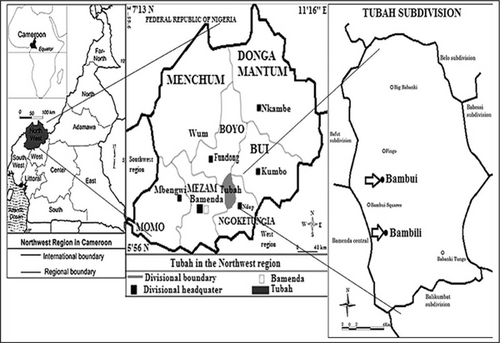
3.2. Estimation of Irradiance Using Different Models for Bambili
3.2.1. Model 1: A-P Model
- 1.
Determination of A-P coefficients:
- 2.
Determination of the mean daily extraterrestrial irradiance (H):
- 3.
The mean peak length of daylight in hours (h):
With the obtained average daily values of irradiance from the A-P model, we further estimated the hourly irradiance.
3.2.2. Model 2: Kaplanis Model
Therefore, the Kaplanis model of Equation (10) becomes completely defined to estimate the irradiance. Figure 2 below shows the Kaplanis model flow chart.
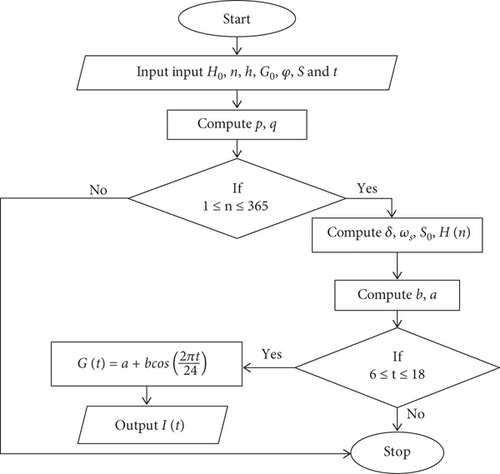
3.2.3. Model 3: Duffie and Beckman Model
- 1.
Daylight hours (N):
- 2.
The zenith angle (θz) and the angle of incidence (θ), measured for the daylight length:
Figure 3 shows the flow chart for the Duffie and Beckman model.
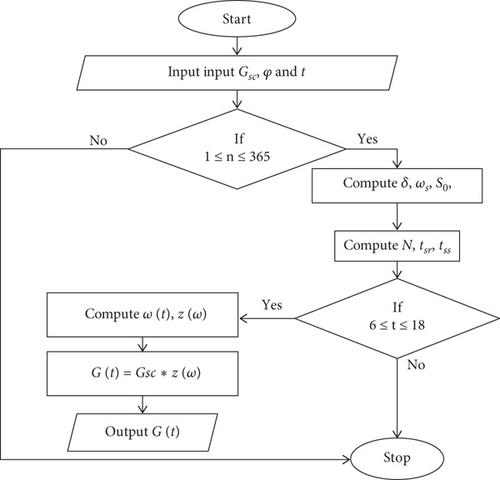
3.2.4. Model 4: Collares-Pereira and Rabl Model
Figure 4 illustrates the flow chart for Collares-Pereira and Rabl.
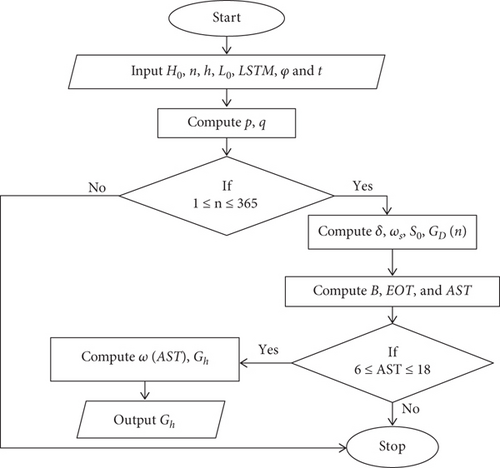
3.3. Estimation of Temperature Using Different Methods for Bambili
The temperature boundary values of these models were bound by the maximum (Tmax) and minimum (Tmin) values [23]. The NASA website and AccuWeather provided the Tmax and Tmin values. For each model, the projected temperatures between dawn and sunset were based on the application of PV systems.
3.3.1. Model 5: WAVE Model
Two intervals were employed with sinusoidal equations to deduce the temperature values, as shown in the following:
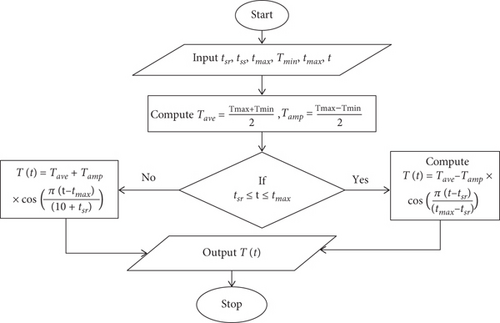
3.3.2. Model 6: Parton and Logan (PL) Model
Here, tmax was 5 h before 6 p.m.
3.3.3. Model 7: SOYGRO Model
In this model, the daytime equation was used for the estimation of the hourly temperature. In addition to the current day’s Tmax and Tmin temperature values and based on the operation time of the photovoltaic system, only the daylight hours for estimation from this model were implemented.
Figures 6 and 7 show the flow chart for the PL and SOYGRO models.
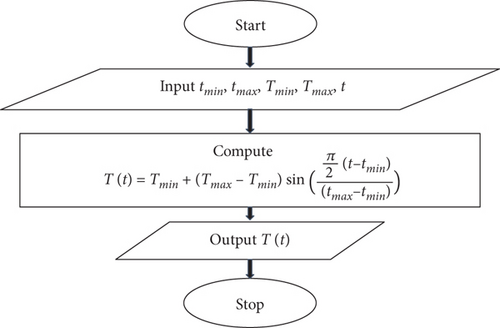
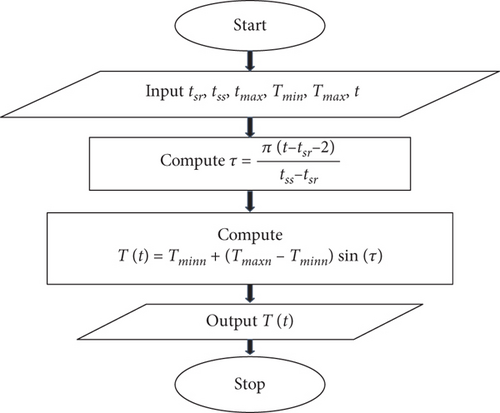
3.4. Hourly Irradiance and Temperature From NASA Website
Hourly irradiance and temperatures were downloaded from the NASA website [25]. These data were obtained from January 2023 to January 2024. Average values were computed and compared with those obtained from the mathematical models and plotted in MATLAB [26].
3.5. Computation of Hourly Power and Energy Using Estimates
| Model | BP3125 | BP3180 |
|---|---|---|
| Pmp (W) | 125 | 180 |
| Vmp (V) | 17.6 | 36.2 |
| Imp (V) | 7.1 | 5.0 |
| Isc (A) | 7.54 | 5.4 |
| Voc (V) | 22.1 | 44.8 |
| α (A/1C) | 0.00065 | 0.00065 |
| β (V/1C) | −0.080 | −0.080 |
3.6. Prediction of Bambili Energy Using the PV Online Software
3.6.1. Method 1: PVGIS Online Software
To access the application, start by typing the following URL into any browser: “https://re.jrc.ec.europa.eu/pvg_tools/en/tools.html#PVP.” The application opened and displayed two field areas. To the bottom left of the app, we entered the location parameters, such as the latitude and longitude of the area. In this field, we entered the values 5.98 and 10.26 for latitude and longitude, respectively, for Bambili. To further set up the parameters, the right field area is used. On the field, we selected OFF-GRID since we were interested in modelling a standalone PV system. On the solar radiation database, we selected PVGIS-SARAH2. On PV technology, we selected Crystalline Silicon; on installed peak PV power in Wp, we entered 125. The system loss was set to 10%. Free-standing was selected for the mounting position. The optical slope was set to 10° and the azimuth angle to zero. After all these parameters were entered, we went forward to visualize the output. The average daily energy (watt-hour) produced by the PV module is plotted with the month.
3.6.2. Method 2: PVsyst Online Software
To open the PVsyst online software, we double-clicked on the installed PVsyst version on our desktop. The first interface was displayed. A grid-connected tab was selected, and a new window opened where we defined the project name, site, and variant. Next, we entered the project name as “PV_Energy_Output_Bambili.” In order to select the site location, Bambili, Cameroon, was not in the default database. We added the data by clicking on the new site tab. Here, we were given two alternatives: either to enter the geographical coordinates or to use the interactive map. The interactive map allowed us to select the location manually on Google Maps. We selected the desired location by giving the locality a name and then zooming in and out of a particular point. The location is then transferred to the geographical coordinates tab as soon as we click on the accepted selected point. We had the opportunity to get the sun path for the selected site. After we had defined a new site by geographical coordinates, PVsyst imported the meteorological data from Meteonorm by default. At this point, we had saved the project. In the next level, we created the system variant. On the variant creation, we had to define two main project parameters, such as the orientation and the system. Clicking on the orientation tab and on the “Select Field Type” drop-down menu, we selected the fixed tilt and set the tilt angle to 10°. We further clicked on the system tab and entered parameters such as the plan power in kilowatt peak and the photovoltaic panel with the rated watt peak. At this junction, we ran the simulation to get monthly and annual energy for Bambili.
4. Results and Discussion
Figure 8 shows the daily global solar radiation in Wh/m2/day for Bambili, Cameroon, using the linear A-P base day of the year model. The results show that the global daily solar radiation (H) for Bambili varies from 4 to 7 Wh/m2/day. The lowest radiation varies between Days 150 and 200, and higher radiation was observed between Days 1 and 100 and between 300 and 365 of the year, which typically is the dry season. Figure 9 shows the plots of the different day-of-the-year models together with the NASA meteorological data. The irradiance obtained with selected models was all above the NASA meteorological website values. This was due to the fact that mathematical models’ maximum values were based on the solar constant with a value of 1000 W/m2. This max value turns to drive the predicted values above the NASA meteorological data. The Collares-Pereira and Rabl model shows a lower prediction throughout the day as compared to Kaplanis and Duffie and Beckman models. However, it agrees better with the NASA meteorological data. All the estimation models perfectly agree from sunrise until 9 a.m. and at sunset, with few deviations. Figure 10 shows the plots of the different mathematical temperature models. Unlike the irradiance models, the WAVE model underestimated the temperature throughout the day as compared to NASA temperature data. Figures 11 and 12 show the energy output over the year from the mathematical models and PV online software. Table 2 shows the numerical monthly and annual values of the energy output for Bambili.
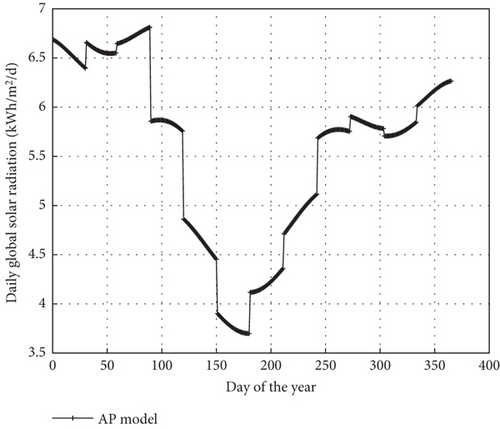
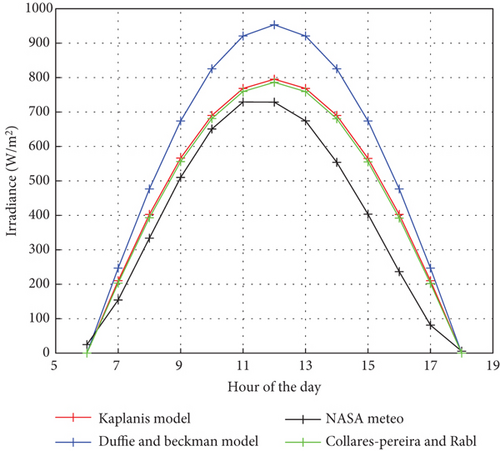
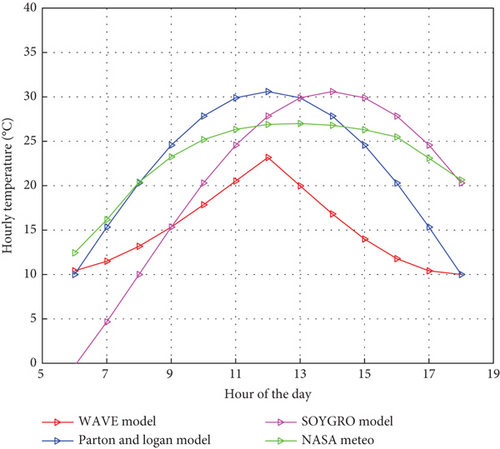
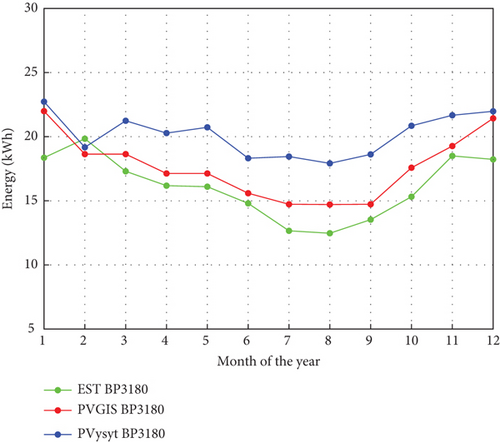
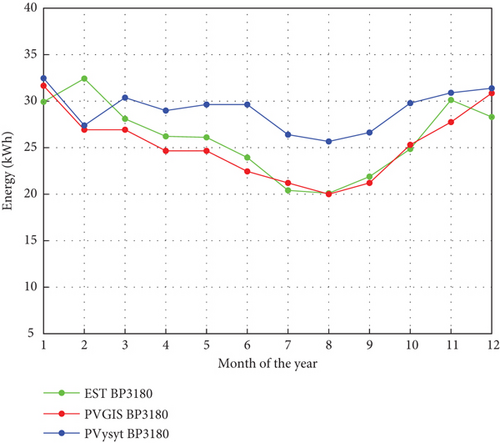
| Month | DOY model | PVGIS | PVsyst | |||
|---|---|---|---|---|---|---|
| BP3125 | BP3180 | BP3125 | BP3180 | BP3125 | BP3180 | |
| January | 18.36 | 29.93 | 21.99 | 31.66 | 22.73 | 32.47 |
| February | 19.84 | 32.43 | 18.64 | 26.93 | 19.17 | 27.39 |
| March | 17.30 | 28.10 | 18.64 | 26.93 | 21.24 | 30.38 |
| April | 16.18 | 26.22 | 17.13 | 24.66 | 20.28 | 28.99 |
| May | 16.10 | 26.11 | 17.13 | 24.66 | 20.73 | 29.64 |
| June | 14.80 | 23.94 | 15.59 | 22.45 | 18.32 | 29.64 |
| July | 12.66 | 20.41 | 14.73 | 21.21 | 18.45 | 26.40 |
| August | 12.47 | 20.10 | 14.71 | 20.00 | 17.92 | 25.67 |
| September | 13.53 | 21.89 | 14.73 | 21.21 | 18.62 | 26.63 |
| October | 15.32 | 24.86 | 17.58 | 25.31 | 20.85 | 29.79 |
| November | 18.50 | 30.13 | 19.27 | 27.75 | 21.67 | 30.90 |
| December | 18.23 | 28.30 | 21.43 | 30.86 | 21.98 | 31.39 |
| Annual | 193.29 | 312.42 | 211.57 | 303.63 | 241.94 | 345.87 |
4.1. Comparative Analysis of Estimated Quantities
The RMSE determines the differences between estimated and NASA meteorological results of solar irradiance and temperature and between estimated energy and those obtained from PV software. Table 3 shows the computed values of this error for the different models.
| Irradiance | ||||||
| Model | Kaplanis | Duffie and Beckman | Collares-Pereira and Rabl | NASA | ||
| RMSE (%) | 7.30 | 14.58 | 6.71 | — | ||
| Temperature | ||||||
| Models | WAVE | Parton and Logan | SOYGRO | NASA | ||
| RMSE (%) | 7.86 | 7.17 | 9.86 | — | ||
| Energy output | ||||||
| PV model | PVGIS | PVsyst | DOY model | |||
| RMSE (%) | BP3125 | BP3180 | BP3125 | BP3180 | BP3125 | BP3180 |
| 1.95 | 2.14 | 4.22 | 4.40 | — | — | |
4.2. Discussion
The simulated results for irradiance and temperature models were compared with those from National Aeronautics and Space Administration data for Bambili. Collares-Pereira and Rabl models show a lower RMSE value of 6.71 for irradiance, while the WAVE model, SOYGRO, and PL temperature models predicted RMSE values of 7.86, 9.86, and 7.17, respectively, compared to the NASA temperature data. PL models from Figure 9 show better performance for temperature estimations from 6 a.m. to noon, while the SOYGRO model performs better from 1 to 6 p.m. for Bambili. All the estimation models agree closely at sunrise and sunset, with few deviations. These estimations can be closer to those of the NASA website if some other parameters are inserted to modify the environmental disturbances, such as sudden cloudiness and rains, among others. The irradiance obtained from the Collares-Pereira and Rabl and temperatures from the SOYGRO models were used to compute the photovoltaic energy output of the BP3125 and BP3180 PV modules. The estimated PV energy output results from mathematical-based day-of-the-year models show a very strong correlation with the PVGIS software results for BP3125 and BP3180, with very low RMSE values of 1.95 and 2.14, respectively. On the other hand, the PVsyst software results show a low correlation with the estimated energy output, with RMSE values of 4.40 and 4.22 for photovoltaic panels BP3125 and BP3180, respectively. Furthermore, the annual estimated energy output of the photovoltaic panels for Bambili was in the range of 193.29–345.87 kWh. This range shows conformity with the range of values stated in the work done by Nfah et al. [20] for the North Region of Cameroon.
5. Conclusions
This work proposed and simulated theoretical models for the estimation of irradiance, temperature, and energy output for Bambili, Cameroon. Methods such as the A-P linear regression model, Duffie and Beckman, Kaplanis, and Collares-Pereira and Rabl models were implemented for estimating the irradiance, while selected methods such as the WAVE, PL, and SOYGRO models were used for temperature estimations. The results obtained from these methods were compared with those obtained from the NASA meteorological database. We deduced that the irradiance prediction for Bambili can be obtained using the Collares-Pereira and Rabl models, while for temperature predictions, the PL models can be employed from 6 a.m. to noon and the SOYGRO model from 1 to 6 p.m.
These estimations can be closer to NASA data if some other parameters are inserted to modify the environmental disturbances, such as sudden cloudiness and rains, among others. With the estimated irradiance and temperature from the selected models, the monthly and annual energy output of solar panels were computed using methods proposed in the literature and PV software. This output ranges from 193.29 to 345.87 kWh. We concluded that for Bambili and other locations without meteorological stations and no internet connections or network service, one can use the day-of-the-year mathematical models to estimate irradiance, temperature, and subsequently the energy output.
Conflicts of Interest
The authors declare no conflicts of interest.
Author Contributions
All authors contributed to the study conception and simulations. Edickson Bobo Yungho and Eustace Mbaka Nfah were responsible for conception, data collection, analysis, and simulations. Tchahou Tchendjeu Achille Ecladore wrote the first draft of the manuscript, and all authors commented on previous versions of the manuscript. All authors were involved in revising the comments given by the editorial board. All authors have read and approved the final manuscript.
Funding
The authors received no specific funding for this work.
Acknowledgments
The authors thank the authorities of the University of Bamenda, Cameroon, for their institutional and administrative support for the completion of this research.
Open Research
Data Availability Statement
The data that support the findings of this study are available from the corresponding author upon reasonable request.




